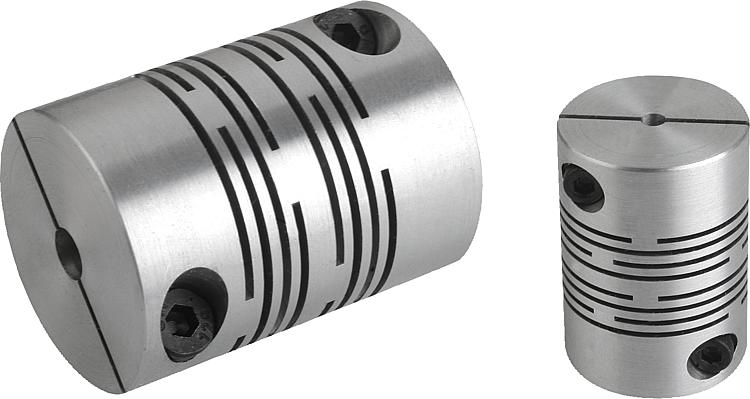“`html
Introduction to Beam Coupling
Beam couplings, also known as helical couplings, are mechanical devices designed to transmit torque between two shafts while accommodating for misalignment, end movement, and other variables. This introduction will explore the design, features, and applications of beam couplings, particularly focusing on their use in cleanroom environments.
Design and Construction
Beam couplings are characterized by their helical cut patterns, which allow for flexibility and strength. The helical design provides a balance between torque capacity and misalignment correction, making them an ideal choice for precise applications. They are typically made from materials like aluminum or stainless steel, ensuring durability and resistance to corrosion.
Features of Beam Couplings
Beam couplings offer several notable features, including high torsional stiffness, low inertia, and the ability to absorb shock and vibration. These features make them suitable for high-performance applications where precision is critical.
Applications in Cleanrooms
In cleanroom applications, where cleanliness and minimal particulate generation are essential, beam couplings are highly favored. Their design minimizes the risk of particle contamination, making them suitable for semiconductor manufacturing, pharmaceutical production, and other sensitive environments.
Key Features of Beam Couplings
- High Precision: The helical design allows for precise torque transmission and alignment correction, essential for sensitive applications.
- Durability: Made from high-quality materials, beam couplings are built to last and resist corrosion.
- Low Maintenance: With no moving parts, beam couplings require minimal maintenance, reducing downtime in critical applications.
- Versatility: They can be customized to fit a wide range of shaft sizes and configurations, offering flexibility for various applications.
- Minimal Particulate Generation: The seamless design of beam couplings ensures that particle generation is kept to a minimum, a crucial factor in cleanroom environments.

Applications and Advantages of Beam Coupling in Cleanroom Environments
Beam couplings are particularly well-suited for cleanroom applications due to the following advantages:
- Reduced Contamination: The design of beam couplings minimizes the creation of particulates, which is critical in maintaining the integrity of cleanroom environments.
- High Performance: Their ability to transmit torque accurately and efficiently makes them ideal for the precise operations conducted in cleanrooms.
- Compatibility: Beam couplings can be made from materials that are compatible with cleanroom standards, such as stainless steel or anodized aluminum.
- Reliability: The robust construction and minimal maintenance requirements of beam couplings ensure reliable performance in critical applications.
- Flexibility: They can accommodate a range of misalignments, which is often necessary in complex equipment setups found in cleanrooms.


How Beam Couplings Work
Beam couplings transmit torque through helical cuts in the coupling body, which flex under load. This flexibility allows for the accommodation of misalignment, while the torsional stiffness ensures accurate torque transmission.
The helical design also acts as a spring, absorbing shocks and vibrations, which protects connected components from damage. Additionally, the continuous nature of the helical cut maintains a constant velocity, ensuring smooth operation.
Finally, the material and precise manufacturing of beam couplings contribute to their overall performance, making them suitable for high-precision applications, including those in cleanroom environments.
Choosing the Right Beam Coupling
- Application Requirements: Consider the torque requirements, misalignment tolerances, and operational speeds of your application.
- Material Compatibility: Ensure the coupling material is suitable for the cleanroom environment and does not introduce contamination.
- Size and Fit: Choose a coupling size that fits the shaft diameters and space constraints of your application.
- Customization Options: Look for customization options that can tailor the coupling to your specific needs, such as custom materials or finishes.
- Supplier Reputation: Choose a supplier with a proven track record of quality and reliability, particularly in cleanroom applications.
Maintenance of Beam Coupling
Maintaining beam couplings is straightforward due to their simple, robust design. Regular inspection for wear and damage, coupled with occasional cleaning, is usually sufficient to ensure their longevity and reliability. It’s crucial to maintain them properly to prevent downtime and preserve the cleanroom’s integrity.
About HZPT
HZPT, established in 2006, is a leading manufacturer and exporter specializing in coupling design, development, and production. With our dedicated design and R&D team of 16 years, we offer customizable products tailored to global customer requirements. Our comprehensive quality control system, from raw materials to finished products, ensures the highest product quality, earning us CE and TUV certifications. Our philosophy, “Customer satisfaction, our pursuit,” drives us to offer the best service, product quality, and competitive prices. Our main products serve various mechanical industries worldwide, with a strong reputation in Europe and America. Choosing HZPT means opting for excellence in quality, reliability, and customer service. We look forward to cooperating with you and establishing successful business relations worldwide.
“`
